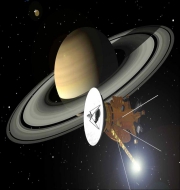NASA’s Cassini spacecraft successfully travels between Saturn and its rings
Recently, NASA’s Cassini spacecraft completed its final close flyby of Saturn’s moon Titan and has now started its final set of 22 orbits before plunging into Saturn on September 15, 2017, and thus completing its 20-year long journey. Already, Cassini has dived successfully through the space between Saturn and its rings, a region no spacecraft has been before. It will perform another 21 dives through the same gap and will send more detailed information about Saturn and its rings. These series of 22 manoeuvres that brings Cassini closer to Saturn’s surface before plunging into it is called as the spacecraft’s “grand finale.”
The spacecraft will provide the radar team with the final set of new images of the hydrocarbon seas and lakes that are present in Titan’s North Polar Region.
Cassini
Cassini spacecraft was named after the 17th-century astronomer Giovanni Cassini. It was launched into space in October 1997. It is a joint endeavour of NASA, European Space Agency (ESA) and Italian space agency, Agenzia Spaziale Italiana (ASI).
Cassini was the fourth space probe to visit Saturn and the first to enter its orbit. The Robotic spacecraft included a Saturn orbiter and an atmospheric probe/lander called Huygens for the Saturn’s moon Titan which entered and landed on Titan in 2005.
Sixteen European countries and the United States make up the team responsible for designing, building, flying and collecting data from the Cassini orbiter and Huygens probe. Huygens was developed by the European Space Research and Technology Centre.
Findings of Cassini
Cassini and Huygens have revealed the existence of earth-like geographic features, great lakes of liquid nitrogen gas on Titan’s surface. Cassini also found evidence for the existence of Underground Ocean on the moon Enceladus. In April, NASA announced that the spacecraft has found evidence that the underground ocean could sustain some form of life. Cassini has generated a rich volume of data that will fuel scientific study for decades to come.
Month: Current Affairs - April, 2017


